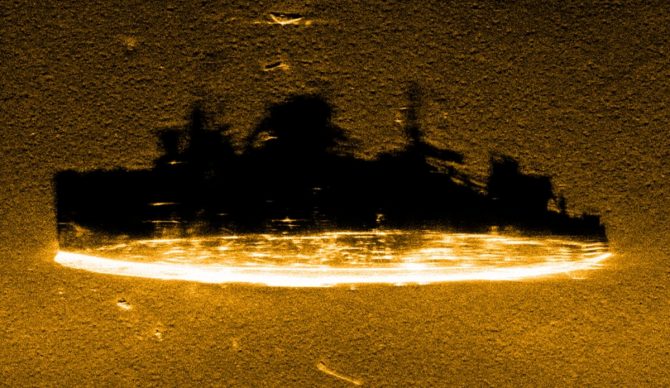
A sonar image of the sunken U.S. Stewart resting on the seafloor of the Cordell Bank National Marine Sanctuary. Photo: Ocean Infinity
Autonomous underwater vehicles (AUVs) are proving to be essential tools in the field of underwater archaeology. Recently, marine robotics firm Ocean Infinity used three of the unmanned craft to locate the wreck of a long-lost piece of U.S. Naval History, as the New York Times reports.
On August 1, Ocean Infinity dropped three large, torpedo-shaped HUGIN 6000 autonomous underwater vehicles off the coast of Northern California. The goal was to find the wreck of the USS Stewart, also known as DD-224 or the “Ghost Ship of the Pacific.” The 314-foot-long U.S. Navy ship was famous for being the only destroyer captured by Japanese forces during World War II. After receiving severe damage during an engagement with Japanese forces, the craft was scuttled. However, later in the war, American pilots discovered that DD-224 had been raised by the Japanese and pressed into service. Though she was eventually recovered by American forces and returned home, her engines gave out and the ship was sunk for a second time, this time off the coast of San Francisco.
It took only a day for the robots to survey 50 square miles of ocean floor and locate the USS Stewart, which was resting on the seabed of the Cordell Bank National Marine Sanctuary. Three days later, another trio of Ocean Infinity-piloted craft captured images of the wreck and found that, despite its age, it was upright and nearly perfectly intact. “This level of preservation is exceptional for a vessel of its age and makes it potentially one of the best-preserved examples of a U.S. Navy ‘four-piper’ destroyer known to exist,” Maria Brown, superintendent of both the Cordell Bank and Greater Farallones national marine sanctuaries, said in a statement.
This marks the third time Ocean Infinity has successfully located a wreck. In 2022, they helped find the U.S.S. Nevada. That same year, the company aided in locating the final resting place of Endurance, a ship sailed by Ernest Shackleton and eventually sunk in the Weddell Sea. The firm became involved in the search for the USS Stewart when Russ Matthews, president of the nonprofit Air/Sea Heritage Foundation, met with Andy Sherrell, the director of maritime operations at Ocean Infinity. It turned out that OI wanted to perform a test on several of its larger drones, and finding DD-224 was an ideal way to do so.
While the discovery concludes the years-long search for the ship’s final resting place, it also highlights the promise of unmanned underwater vehicles for marine archaeology. “We’re in the midst of, I think, a radical change in ocean discovery,” said Jim Delgado, a senior vice president at SEARCH, Inc., a maritime archaeology firm involved in the DD-224 discovery.

